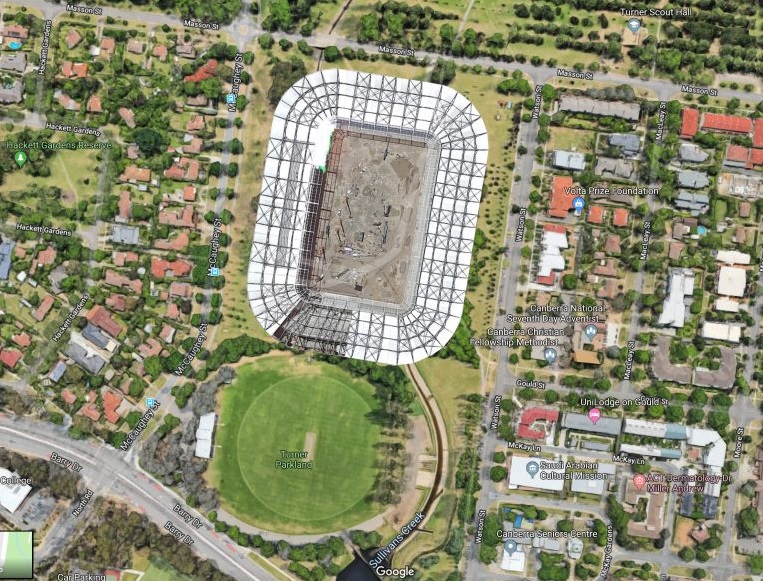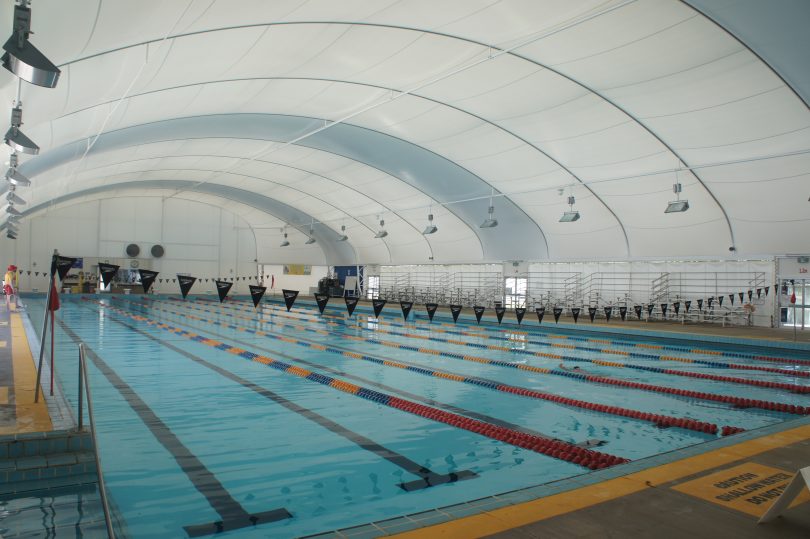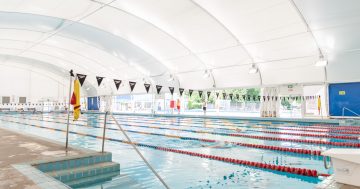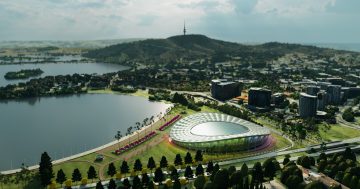
An overlay of Bankwest Stadium in Parramatta (30,000 seats) on the Turner space to scale shows a neat fit for the proposal. Image: Supplied.
It has been interesting to watch the latest round of excitement and debate that has been generated by the perennial proposal to replace our tiring stadium in Bruce with a new facility in Canberra’s CBD.
This government’s proposal to build a new stadium on the existing Civic Pool site was originally put forward as part of the much grander City to the Lake project, a master plan that seems to have fallen foul with the City Renewal Authority.
City to the Lake was to include a new mixed-use precinct and aquatic facility in West Basin, a new convention centre on City Hill, a new stadium on the existing pool site and a raft of new developments on the remaining surface car parks and surplus sites scattered through the CBD.
A significant upgrade to Parkes Way was also envisaged, lowering and shifting the existing alignment to the south, relocating Coranderrk Pond and bringing the City closer to the Lake while ensuring the preferred north-south alignment for the new stadium.
While there are a good many arguments for bringing Canberra Stadium closer to the CBD, one has to wonder whether the original vision is still relevant and realistic given the changes that we have seen since City to the Lake was first announced. For example, the various planning studies for West Basin in recent years suggest the Territory is still predisposed to development in this area, however, the new aquatic facility seems highly unlikely, raising the obvious question about a replacement for Civic Pool.

The Civic pool also requires refurbishment but how can it best meet the needs of the growing Civic population?
The University of New South Wales is also lining up a new development for the car park site opposite CIT and, if recent news is true, a good portion of the CIT site itself, and a new convention centre on City Hill seems to be falling further and further down the list of infrastructure priorities, one imagines in large part due to the price tag that was attached to the Fuksas design.
If the ACT Government is committed to bringing UNSW to City east and up to 20,000 new residents to Canberra’s CBD in the coming years, the need for a City aquatic centre is only going to grow. With this in mind, it would be timely to explore alternatives to the current proposal that might deliver similar or greater benefits (economic, social and environmental) than the original vision but with far less inconvenience and a much smaller price tag.
Consider, for example, the following proposal: develop a new City Stadium on the Turner Parklands to the north of ANU — the site is large, flat, perfectly aligned, close to light rail, well located to the RUC and new Raiders facility at Braddon, and next door to a huge and growing student population.
The existing pool site can immediately be taken to market for redevelopment with a requirement to build and operate a new publicly accessible Olympic Pool as part of the new development — the condition of Civic Pool is much worse than Canberra Stadium and it should be replaced as a matter of priority.
The need to spend many hundreds of millions of dollars on upgrading Parkes Way is eliminated, along with the many years of traffic carnage that would ensue if this major arterial was to be fully redeveloped. The government could instead significantly widen the bridges connecting Civic to Commonwealth Park and New Acton to West Basin to remove the conflict between pedestrians and cyclists and in parallel, Coranderrk Pond could be replaced with traffic lights to manage the morning and evening peaks that are currently exacerbated by the existing roundabout.
Dan Stewart has a long history in Canberra urban planning. He spent 14 years in ACT government executive positions before moving to the private sector.
What are your thoughts on this issue? Comment below.

















